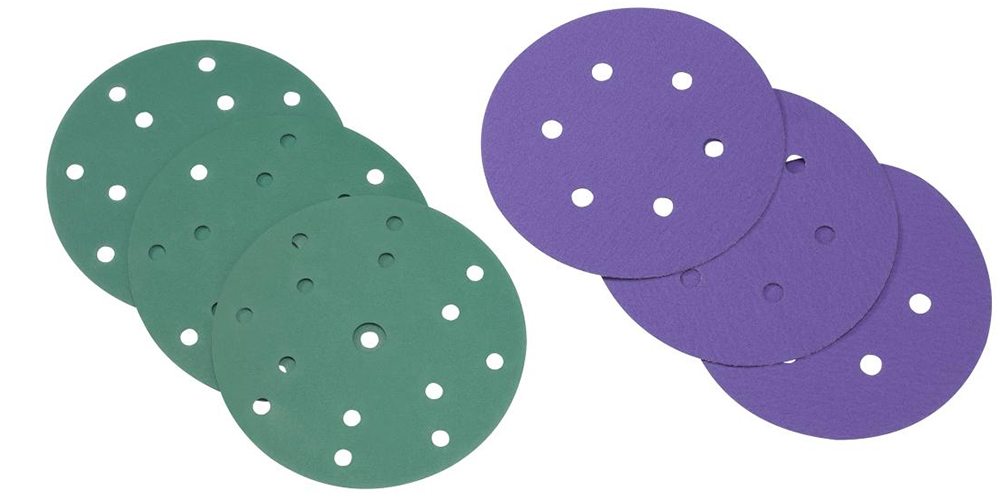If you’re reading our blog, it may not come as much of a surprise to you that the term “sandpaper” is actually a misnomer, as the grittiness of sandpaper is not actually made from sand, like at the beach, and this grit is not always even attached to paper.
So, if it’s not actual sand, then what is it? And, what are the differences between the various abrasive materials?
Sandpaper is actually a type of coated abrasive, meaning, it is made from some type of abrasive “grain”, such as the types we are going into in this blog, which is affixed to some kind of backing – often paper, cloth, plastic, or even foam sponges or mesh. There may or may not be other added fillers or coatings, such as stearation.
These days, there are several types of abrasive materials used on sandpaper products, including a few natural rocks/minerals and a handful of synthetic substances, manufactured in labs, each with their own advantages and disadvantages.
The most common natural minerals used in abrasives are emery and garnet, while four common manmade types are silicon carbide, aluminum oxide, ceramic alumina and alumina- zirconia. Each varies in longevity, coarseness/aggressiveness, amount of friction required, friability, cost, ideal application, available grit sizes and coating and what formats of products they are available on, such as disks, sheets, or belts.
Before we discuss each of these grains, it’s important to consider why these characteristics matter. First, and let’s be real, does anyone really enjoy sanding? If you do, let us know!! …But for the rest of us, sanding can be a bit time consuming, boring and even a pain on the hands, so, wouldn’t it be great if we could make the process more efficient, and more effective? Other than making it merely tolerable with some headphones and great music, we can often speed up the process by using the proper type of abrasive product for our application with proper technique, which will save time and resources.
Additionally, using the proper abrasive grain / project material combination, as well as proper technique and pressure, can also help to reduce sanding costs by allowing your products to last longer. One way this happens is thanks to using products that create less friction, and therefore less heat, which causes the abrasives to cut more effectively, not burn your material and clog up less. Furthermore, the friability, or the characteristic that allows grains to break to form new, sharp edges (self-sharpening), allows you to go longer before the sandpaper wears out.
Now that you know why it’s important to choose the right grain for the project, let’s discuss each of the four options we have available.
1.Aluminum Oxide-The versatile powerhouse of abrasives
The most versatile of the synthetic abrasive grains, Aluminum Oxide commonly comes in three types: pink, white and brown, or semi-friable. Aluminum oxide is a chemical compound of aluminum and oxygen formed by fusion and then broken down and sorted by grit size through a series of mesh screens. Each of the type measures at about 9 on the Mohs Hardness Scale, a measurement scale that defines how resistant materials are to scratching. The Mohs scale places common minerals on a scale of one through ten, starting with Talc at the bottom and Diamond at ten.
2.Silicon Carbide – Self-Sharpening And Great For Beautiful Finishes And Glass
Silicon Carbide, another popular grain type, is a semiconductor containing silicon and carbon and is produced through carbothermal reduction. It is the hardest common abrasive grain, other than diamond, and measures at a 9.5 on the Mohs Scale of Hardness.
3.Ceramic Alumina – Long Lasting, Great For Metal Finishing
Ceramic alumina is a long-lasting synthetic grain produced directly as a grain through an aqueous dispersion of fine aluminum oxide powder. While it can often be more expensive, it lasts longer and provides a cooler sanding experience than aluminum oxide. Often simply referred to as ceramic, this grain works best on metal, stainless steel in particular, and requires a hard surface/pressure in order to activate the friability. While it can be used on wood, it will be very aggressive ploughing through the wood instead of cutting it. This could lead to a very uneven scratch pattern which will result in a poor finish.
4. Alumina-Zirconia – The Grittiest Of Them All
Alumina-Zirconia, also referred to as zirc or zirconium, is produced by die-casting and is typically available in only coarser grits, up to 120, on belts and disks for power sanding units. Because this grain is best for heavy stock removal in mills, an initial sanding of raw woods, and removing burrs from very hard metals, it is mostly available on heavy cloth backings with mostly open coats, to provide a sturdy product with space for a lot of material to accumulate. This allows the products to withstand medium to high pressure and avoid clogging too quickly. If you have a lot of rough sanding to do for raw woods, rust or other metal work, choosing zirconia might be the best option, in spite of a potentially higher price, because it will last longer, be more friable, and provide a cooler sanding experience than aluminum oxide.
As you can see, there are certainly many aspects that will influence which abrasive grain, and therefore, which “sandpaper” will be best for your particular application. While aluminum oxide is the most common, and generally most affordable of our products, choosing another material, or combination of materials and grits, might ultimately be more cost effective, longer lasting and even more effective at the job, even if you only work with one base material.
Want to see our BINIC Sanding Abrasives, please contact at: sale3@binic-china.com . See more at: www.binictools.com





